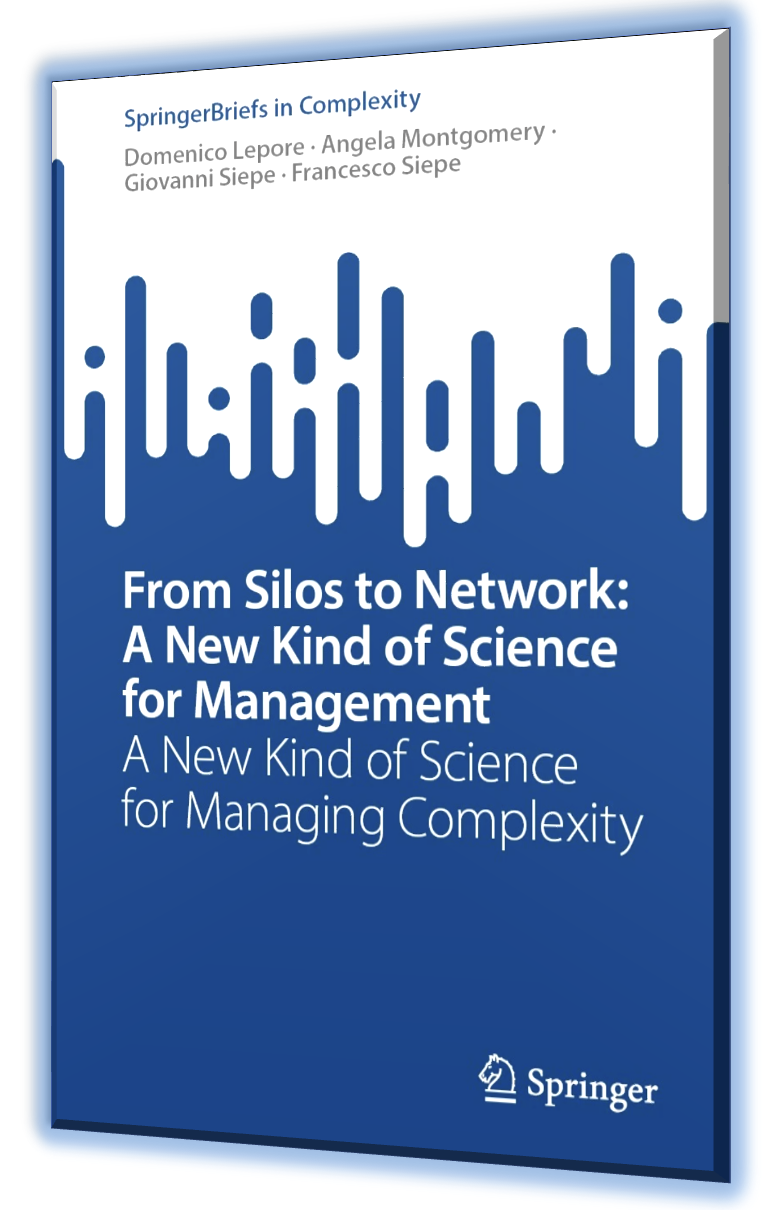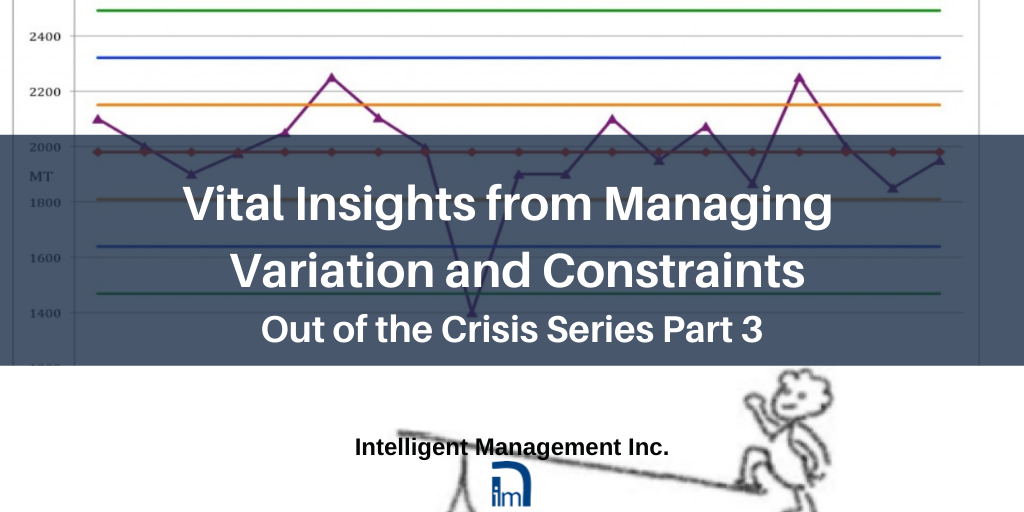Putting new knowledge to work: Managing Variation and Constraints
Stamp out the fire and get nowhere. Stamp out the fires puts us back to where we were in the first place. Taking action on the basis of results without theory of knowledge, without theory of variation, without knowledge about a system. Anything goes wrong, do something about it, overreacting; acting without knowledge, the effect is to make things worse.
(W. Edwards Deming in the documentary ‘Deming of America’.)
The concepts of network, nodes and hubs have become part of our contemporary consciousness thanks to the development of social networks. This is much less true for the concept of a systemic worldview that embraces complexity and the related principles that govern how we interact. Why is it so much harder for people to adopt a systemic worldview? Still today, schools perpetuate a vision of the world based on separation, where subject matters are taught largely independently of each other in much the same way as has been done for decades. When it comes to business, the accounting methods used to measure performance and set prices that “determine profit” are based on the idea that any business is made up of separate parts and if we optimize each part then we optimize the whole. This line of thinking leads to:
- A vision of an organization that is hierarchically fragmented, rather than systemic
- The pursuit of local optimization at the expense of global optimization
- A management approach oriented toward a “cost reduction world”, rather than an “increasing performance world”
Ever since we have gained a new way of understanding phenomena based on complexity, we have known that these are fundamentally flawed ways of looking at reality. They do not provide the vital insight that businesses and organizations need today in order to understand how they are performing as an interconnected whole. What we require, instead, is a systemic measurement, something that lets us know how the whole system is performing so we can make informed decisions.
There are two fundamental measurements that help us to understand how a system is performing:
- Variation
- Throughput as defined in the Theory of Constraints.
Part of Dr. Deming’s major contribution was to insist on the understanding and management of variation. Every human process, from waking up in the morning to sending a man to the moon, is affected by variation; a process can never be repeated in an identical way. Incorrectly managed variation in manufacturing, for example, leads to scrap, waste and money lost.
It is impossible to eliminate all variation because entropy exists and is intrinsic to any process. However, through correct statistical methods it is possible to understand variation, measure it, manage it and take actions to reduce it. This requires a mindset of continuous improvement as opposed to monitoring. In spite of the disastrous and costly effects of ignoring the importance of statistical studies, surprisingly few managers are conversant with them.
Throughput, as defined in the Theory of Constraints, is the pace at which the system generates units of the goal (through sales if the organization is for-profit). The Theory of Constraints was designed to accelerate the flow of material, money and information through a system and serves as a highly effective way to produce the maximum with the resources we have available. The Theory of Constraints calls for the identification of a strategic constraint that becomes the leverage point that dictates the pace at which we produce units of the goal (throughput).
We can increase the amount of throughput that we produce in the entire system by designing all the other activities in the organization to “subordinate” to the constraint so that it works constantly, like a heartbeat that must never fail. To do this, we need some “excess” capacity in the system to protect it from fluctuations, in other words, to absorb the cumulative variation generated by the system and to prevent this variation from generating disruption to the constraint. This is very far from what Lean methodologies seek to achieve. In Lean, we will find no concept of protective capacity or buffers. This approach can work in a limited number of situations where there is a highly predictable environment. However, in any event, the absence of an identified, strategic constraint ultimately leads to a series of interconnected bottlenecks. In a situation of crisis, this comes dramatically into focus.
An article in the Washington Post, ‘The virus shows that making our companies efficient also made our country weak’ criticizes the relentless pursuit of efficiency that Lean thinking has spurred globally. The author, Roger Martin, concludes, “As this pandemic has shown us, we need to value other qualities such as redundancy and buffers, if we are to tackle the next catastrophic event.” Roger Martin is the former Dean of the Rotman Business School at the University of Toronto. Paradoxically, Rotman, like the vast majority of Business Schools, still today offers courses in Lean & Six Sigma. While the latter is an outright statistical hallucination unworthy of any comment, the former is yet another worldview that reveals a linear mindset. It captures very poorly the essence of Deming’s message and perpetuates a cost accounting worldview. In a world dominated by complexity, we continue to adopt linear thinking and engender anachronistic approaches and methods at our peril.
Hardly any Business School offers courses in the Theory of Constraints, the natural habitat of what Martin describes as “redundancies and buffers”. The word redundancy is misleading. To run well, companies can certainly eliminate redundant activities, for example the unnecessary repetition of tasks that can occur because people work in silos rather than as a whole system. However, the systemic view that the Theory of Constraints instills demonstrates that there must always be protection capacity in the system to make sure that the constraint is always subordinated to and able to work constantly as it is the constraint that dictates the pace at which the system generates units of the goal (throughput). Moreover, there must always be a buffer to protect the constraint and Buffer Management is a foundational element of the Theory of Constraints.
Thanks to Deming and Goldratt, we learn fundamental aspects about systems (variation and constraints) and how to manage them in the most effective and productive way. Only if we have a deep understanding of the behavior of a system, or ‘Profound Knowledge’ as Deming called it, can we hope to manage a system for success. Without this knowledge we are flying blind. For Deming, quality management means a commitment to the continuous improvement and innovation of products and processes. To achieve this, it is mandatory to build the organization as a clear and shared system in which interpersonal relations are not of dependence but interdependence, where communication is encouraged, and where the needs of the individual are catered to and combined with group work. An organization determined to build Quality helps its people to understand the systemic nature of their work. It encourages the study of effects in order to discover their profound causes and orients itself to looking at processes instead of just concentrating on results. Deming’s vision of Quality entails a radical re-thinking of company management; it requires a purely intercultural approach, and the study of areas of knowledge that are very different from each other. Deming’s work is generally referred to as “Deming’s Philosophy.” Its bases are contained in the Theory of Profound Knowledge (TPK), or, in his own words, “knowledge for leadership of transformation.” They are:
- Appreciation for a system
- Knowledge about variation
- Theory of knowledge
- Psychology of individuals, society, and change
Goldratt further enlightens us by emphasizing that every system has a constraint, whether we know it or not, a “limiting factor” that dictates the throughput the organization as a whole can produce. Once this is understood, the constraint provides the organization with a strategic leverage point that allows optimization of the way all the resources available contribute towards the goal. The Theory of Constraints enables radical improvement in the performance of the system as a whole through the rethinking of how every aspect of the company is orchestrated and synchronized on a strategically chosen constraint. The Theory of Constraints strengthens the ability to think, plan and act systemically. One offspring of this is a new set of measures and operational measurements that provide the information needed (and completely missing from traditional accounting) about the speed of flow of throughput and that support decisions regarding profitability and investment. Given the monumental contribution to management thinking and science that Deming and Goldratt have produced, the absence of the Theory of Profound Knowledge and The Theory of Constraints from the curricula of the majority of Business Schools underlines the gap in knowledge that still exists today in the preparation of leaders and managers.
For over twenty years, in different capacities and in both Europe and North America, the authors of this white paper have employed systems science to enhance the business performances of a variety of organizations; industry primarily, but also government, healthcare and education. Starting in the mid 1990s we began to integrate the two management theories of Deming and Goldratt and this integration evolved into a coherent systems-based methodology that we call ‘The Decalogue’. We first published our findings in 1999 in our book ‘Deming and Goldratt: the Decalogue’ (Lepore & Cohen, North River Press). As we worked on various implementations of the Decalogue supported by a team of physicists, mathematicians and engineers, the substantial improvement in performance that companies were able to achieve confirmed the validity of the Decalogue approach. It also became evident, however, that the majority of organizations are shaped and measured in a traditional way that prevents them from reaping fully the multiple benefits of managing themselves as a whole system. The prevailing hierarchical/functional style of organization inevitably leads to silos that prevent companies from accelerating flow of throughput and achieving their potential with the resources they have available. We came to realize that Network Theory could become central to understanding and developing more effective ways for everyone in an organization to contribute to the goal in an operational way, a discovery that we outline in several books and publications that we have produced (see bibliography.)
Other articles in this ‘Out of the Crisis’ series:
Part 1: A Serious Knowledge Gap Affecting Leaders and Executives
Part 2: What’s Wrong with Organizational Structures?
Part 3: Viral Insights from Managing Variation and Constraints
Part 4: How to Manage Decentralized Work
Part 5: Learning to Think Systemically to Make Informed Decisions and Pre-empt a Crisis
Part 6: Identifying Assumptions to Unlock Innovation and Move Beyond the Crisis
Part 7 A New Economics for Sustainable Prosperity
Contact: intelligentmanagement@sechel.ws
SCHEDULE AN INTRODUCTORY CALL WITH US







Leave a Reply